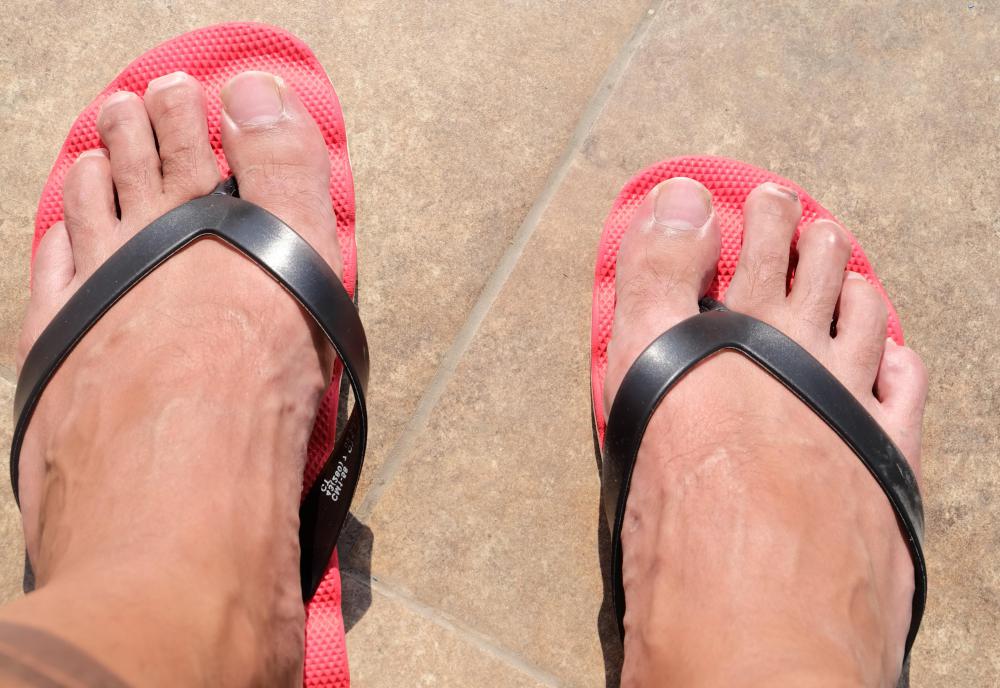At TheHealthBoard, we're committed to delivering accurate, trustworthy information. Our expert-authored content is rigorously fact-checked and sourced from credible authorities. Discover how we uphold the highest standards in providing you with reliable knowledge.
What Are the Signs of Toenail Fungus?
The signs of toenail fungus, a condition officially known as onychomycosis, most often include abnormalities in the color or integrity of the toenails. Typically the fungal infection starts as a discoloration on the edge of the toenail that subsequently increases in area with the spread of the fungus. Patients with this condition can experience toenail thickening, splitting, or loss of the entire nail. They might have itchiness or pain associated with the infection. One complication of having toenail fungus could include the development of a skin infection called cellulitis, which can be recognized as a streaky red rash.
Often the first signs of toenail fungus are abnormalities in the toenails. Patients might notice a brown, yellow, or white discoloration of the nail. Many times the discolored spot under the toenail first appears at the edge of the nail, and out of all of the toenails, the big toenail is most commonly affected first. With time, this area of discoloration grows across the nail and down towards the cuticle. The advancement of the spot is usually slow, with increases in size only apparent after monitoring the toenail for weeks or months.

In addition to discoloration of the toenail, other signs of toenail fungus can include other abnormalities in the appearance of the toenail. Some patients might experience a thickening of the toenail. They also might notice cracking, splitting, or splintering. This often occurs when the fungus destructs the support structure of the toenail, thus making it susceptible to mechanical damage.

Progression of the fungal infection can lead to other signs of toenail fungus. Although initially patients do not report any discomfort associated with the fungus, with additional growth they could report pain in the toenail or discomfort of the surrounding skin. They might also notice itchiness in the area surrounding the toenail.
If the toenail fungus disrupts enough of the nail beds underlying the toenails, patients might lose the toenails completely. This can be a dangerous occurrence because it can expose vulnerable underlying skin to bacteria and other pathogens. Patients with diabetes who lose toenails are particularly susceptible to the development of cellulitis, which is a bacterial infection affecting the body tissue underlying the skin. Cellulitis can be identified as a streaky red rash that advances through the skin in a linear fashion.

Toenail fungus is often associated with athlete's foot, also known as tinea pedis. Both conditions are considered to be fungal infections. They typically are caused by different types of fungus, however. Patients might develop both types of fungal infections simultaneously due to environmental conditions that promote infection, such as walking around barefoot in communal areas or continually wearing closed damp shoes. Signs of athlete's foot can include skin itchiness, skin flaking, and discoloration of the skin, and it most commonly affects the skin between the toes.
AS FEATURED ON:
AS FEATURED ON:














Discussion Comments
Something else that toenail fungus can do if it goes untreated is deform the shape of toenails. That's what happened to me. My toenails turned yellow first and then the sides started to move up and pus formed underneath. Sorry for the description, but that's how bad toenail fungus gets without treatment.
@ddljohn-- Like the article said, it takes a long time for toenail fungus to take over the nail. So you might have to wait for weeks and months to confirm that the white spot is a toenail fungus symptom.
If the white spot doesn't get bigger and if it grows out with the nail, then it's not toenail fungus. If you hit your toe on something, you can get a spot like that. I had one too and it simply grew out with my nail.
If it doesn't grow out with your nail and gets bigger, you can bet that it's the beginnings of a fungal infection.
There are various remedies out there like vinegar soaks, bleach soaks, use of chest rub, mouthwash or tea tree oil. But you might want to see your doctor for a diagnosis and anti-fungal medication instead because these remedies take a long time to work.
I noticed a white spot in the center of my big toenail last week. I've been observing it to see if it goes away. It hasn't gone away but it doesn't seem to be spreading either.
What can I do to get rid of toenail fungus at this stage? Are there any home remedies? I've never had foot fungus before and I don't want the infection to spread.
Post your comments